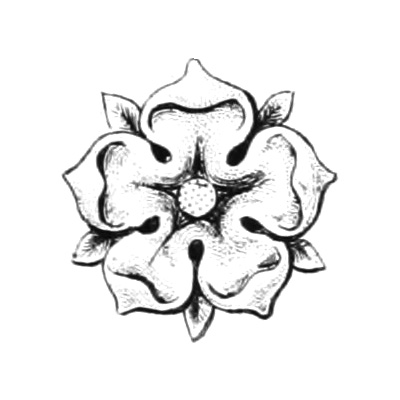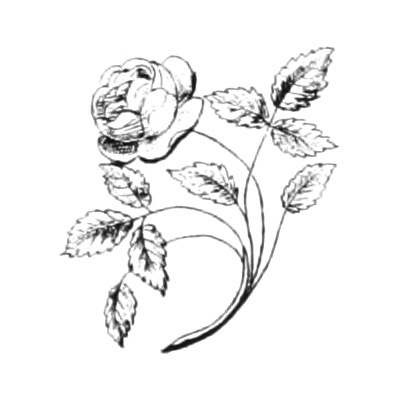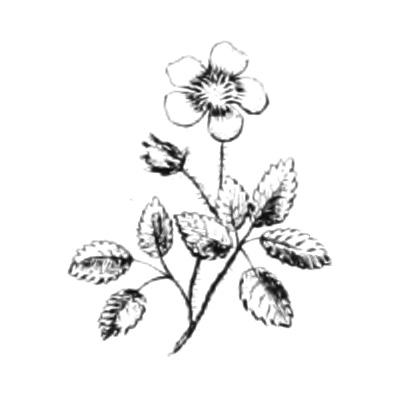- rose: различия между версиями
м (Замена текста — «[[- Роза» на «[[- роза») |
|||
| (не показаны 4 промежуточные версии этого же участника) | |||
| Строка 4: | Строка 4: | ||
[[Файл:Elvn-44 (4).jpg|мини|200x200пкс|Rose and Thistle conjoined]] | [[Файл:Elvn-44 (4).jpg|мини|200x200пкс|Rose and Thistle conjoined]] | ||
[[Файл:Elvn-44 (27).jpg|200px|мини|справа|Bramble, or Wild Rose]] | [[Файл:Elvn-44 (27).jpg|200px|мини|справа|Bramble, or Wild Rose]] | ||
| + | |||
| + | ROSE. Is borne depicted naturally, and heraldicly. P. 44, f. 1 and 3. | ||
| + | |||
| + | '' The Heraldic Rose is always shewn full blown, with the petala, or flower-leaves expanded, seeded in the middle, and bached by five green barbs, or involucra ; this Rose, when gules, is never to be called proper, whereas the rose borne naturally, is always when gules termed proper, and is always stalked and leaved, and termed a Rose slipped. The Heraldic Rose may be of any tincture, and is said to be barbed and seeded of such a colour, which must be expressed, unless the seeds are yellow and the barbs vert, when it is blazoned a Rose of such a colour, seeded and barbed proper. The Rose is used as a distinction for the seventh sou. See Distinction of Houses. P. 46.'' | ||
| + | |||
| + | ROSE HERALDIC. P. 44, f. 1. | ||
| + | |||
| + | '' The White Rose the badge of the House of York, and the Red Rose the badge of the House of Lancaster. P. 25, f. 2 and 4, The White and Red-Rose united and imperially crowned is the Badge of England. P. 3, f. 21. Also termed a Double Rose,'' | ||
| + | |||
| + | ROSE, stalked and leaved. P. 44, f. 3. Also termed a Damask-rose, stalked and leaved. A Damask rose, with leaves and thorns. P. 25, f. 27. | ||
| + | |||
| + | (ELVN) | ||
| + | |||
| + | |||
Rose рус. роза | Rose рус. роза | ||
| Строка 45: | Строка 59: | ||
:«A dexter half of a double rose, gules and argent, barbed and seeded proper, impaled with a semicircle per pale vert and azure, therein a sheaf of arrows or, armed and feathered of the second, and tied together with a tasselled cord, forming a knot of the first; the whole rayonnant, and ensigned with a royal crown without arches proper» – Badge of Queen MARY. | :«A dexter half of a double rose, gules and argent, barbed and seeded proper, impaled with a semicircle per pale vert and azure, therein a sheaf of arrows or, armed and feathered of the second, and tied together with a tasselled cord, forming a knot of the first; the whole rayonnant, and ensigned with a royal crown without arches proper» – Badge of Queen MARY. | ||
:«The two roses united one within the other royally crowned» – Badge of the House of STUART. | :«The two roses united one within the other royally crowned» – Badge of the House of STUART. | ||
| − | [ | + | – [[PARC]] |
| + | |||
| + | [[- роза|Роза (геральд.)]] | ||
| + | |||
| − | + | Rose: | |
| + | *«Us. shown boutonnée, seeded, and occ. barbé, barbed». | ||
| + | *1679 г. — «De plusieurs especes, fleur que l’on trouve en armes». | ||
| + | *1772 г. — «La rose s’appelle soutenue, quand elle est figurée avec sa queue, elle est quelquefois d’un même, et quelquefois d’un différent émail, mais toujours épanouie, et tantôt avec les pointes de la châsse d’un émail différent des feuilles». | ||
| + | *1885 г. — «Elle a cinq feuilles extérieures, un bouton au milieu et cinq pointes entre les feuilles, représentant les épines, d’autres disent les boutons». | ||
| + | *1887 г. — «La rose héraldique est représentée sans tige et montre cinq feuilles. On en trouve d’un plus grand ou d’un moindre nombre de feuilles. Elle est dite boutonnée lorsqu’il s’agit de l'émail du coeur, et barbée par rapport aux brins, d’ordinaire de sinople, qu’on voit entre les feuilles. Quelquefois la rose héraldique est tigée et feuillée. La rose des jardins, soutenue d’une tige avec ou sans feuilles, s’appelle rose naturelle». | ||
| + | *1899 г. — «Cette fleur est figurée épanouie, ayant cinq feuilles entre lesquelles paraissent des petites pointes ou barbes; lorsque la rose est représentée avec une queue, on la dit tigée; feuillée si la queue est garnie de feuilles; lorsque ces parties et le coeur de la fleur, qui se dit boutonné, sont d’un émail spécial il faut l’indiquer en blasonnant». | ||
| + | *1901 г. — «Fleur représentée sans queue ouverte et épanouie. Elle a cinq feuilles extérieures, un bouton au centre et cinq points entre les feuilles. Elle peut être boutonnée, soutenue, tigée ou feuillée d’un émail particulier». | ||
| + | *1905 г. — «Meuble de l'écu qui représente l'églantine des haies (rose sauvage), mais avec quatre pétales seulement, et un petit sépale du même émail entre chaque». | ||
[[Категория:Терминология английская]] | [[Категория:Терминология английская]] | ||
Текущая версия на 20:01, 11 июля 2021
ROSE. Is borne depicted naturally, and heraldicly. P. 44, f. 1 and 3.
The Heraldic Rose is always shewn full blown, with the petala, or flower-leaves expanded, seeded in the middle, and bached by five green barbs, or involucra ; this Rose, when gules, is never to be called proper, whereas the rose borne naturally, is always when gules termed proper, and is always stalked and leaved, and termed a Rose slipped. The Heraldic Rose may be of any tincture, and is said to be barbed and seeded of such a colour, which must be expressed, unless the seeds are yellow and the barbs vert, when it is blazoned a Rose of such a colour, seeded and barbed proper. The Rose is used as a distinction for the seventh sou. See Distinction of Houses. P. 46.
ROSE HERALDIC. P. 44, f. 1.
The White Rose the badge of the House of York, and the Red Rose the badge of the House of Lancaster. P. 25, f. 2 and 4, The White and Red-Rose united and imperially crowned is the Badge of England. P. 3, f. 21. Also termed a Double Rose,
ROSE, stalked and leaved. P. 44, f. 3. Also termed a Damask-rose, stalked and leaved. A Damask rose, with leaves and thorns. P. 25, f. 27.
(ELVN)
Rose рус. роза
- фр. rose
- англ. rose
Цветок часто представленный в гербах и еще чаще в фигурных девизах. В древнейших гербовниках представлен тольку у ветвей семейства D'ARCYS. Изображается без стебля если только не указано, что роза «stalked» или «slipped». Геральдическая роза имеет пять лепестков, как на приведённом примере, но встречаются примере шести и четырёх лепестковых роз. Поименование шипов (barbs) - пяти листков чашечки(calyx), и семенника (central seeds) предполагает их зелёную и золотую/жёлтую окраску соотв. В системе понижающих меток соответствует седьмой ветви/дому. Нередко образуют венки (chaplet, см.), иногда коронуются (crowned).
- «Ermine, a rose gules, barbed and seeded proper» – BEVERLEY, Yorkshire.
- «Philip DARCY, d'argent a trois roses de goules» – Roll, temp. HEN. III.
- «Sire Robert DARCY, de argent a iij roses de goules od la bordure endente de sable» – Roll, temp. ED. II.
- «Sire Johan DARCY, de argent a un escuchon de sable od les rosettes de goules assis en la manere de bordure» – Ibid.
- «Sire Felyp DARCI, de argent a iij roses de goules» – Roll, temp. ED. II.
- «Sire William de CONSINGTONE, de azure a iij roses de or» – Ibid.
- «Monsire de ROSTLES, gules vi roses argent» – Roll, temp. ED. III.
- «Argent, on a bend azure three roses of the first» – CAREY, co. Oxford.
- «Or, a stag trippant azure on a chief of the last three roses argent» – FRUID, Scotland.
- «Argent, a cross engrailed gules between four mullets azure, on a chief or three damask roses of the second seeded gold barbed vert» – ALLGOOD, Nunwick, Northumberland.
- «Argent, a chevron sable between three roses gules slipped vert» – Nicholas WEST, Bp of Ely, 1515-33.
- «Argent, on a fesse vert between three damask roses barbed and seeded proper four ermine spots of the field» – WILLAUME, Tingrave, co. Bedford; granted 1767.
- «Argent, on a mount vert three heraldic roses gules stalked and leaved proper» – Dr.PEARCE, Dean of ELy.
Также встречается двойная роза, когда одна, помещается в центр другой, нередко имеющие разную окраску – белая в красной или наоборот. Термин «розетка» (rosette) испоьзуется лишь когда их несколько..
- «Azure, a saltire argent charged in the centre with a double rose gules» – OPPIN, Saxony.
- «Argent, a cross gules; in the dexter canton a dagger[probably meant for the sword of S.Paul] of the second; on a chief azure a double rose red and white barbed vert between two fleurs-de-lis or» – CHRIST'S HOSPITAL, London.
- Symon FRESEL, de cele gent
- Le ot noire а rosettes de argent
- Roll of Carlaverock.
Ветви розы (rose branches), побеги (slips) и листья (leaves) иногда используются самостоятельно. В одном древнем примере обнаруживается фраза «3 rosers».
- «Argent, two bars azure, over all a lion rampant or, holding in the dexter paw a rose branch gules» – TUDMAN.
- «Argent, on a mount vert three rose sprigs, the roses gules, the leaves and stalks proper» – ROSECREEG, Cornwall.
- «Argent, a rose and thistle conjoined paleways proper» – ASHTON.
- «Or, a rose leaf in bend sinister vert» – BENDLISE.
- «Gules, a chevron argent between three rose leaves of the second(another, or)» – Sir John ROSE.
- «Le Counte de RAMPSUILE dor a treis rosers; sur chekune roser une rose; chekune roser verte» – Roll, temp. HEN. III. (In another copy, possibly of the same original Roll, «Le Countee de RUMMESVILLE, dor trois roses [c]harges ove 3 roses vert.»)
Использование розы как политического символа можно проследить в войне домов Йорка и Ланкастера, первые пользовались белой розой, а их противники – красной, которые нередко описываются соотв как роза Йорка и роза Ланкастера. Говорят, что первыми их восприняли John of Gaunt, герцог Ланкастер и его брат Эдмунд, герцог Йорк (Edmund). Обе розы иногда окружены лучами, и описывались как «en soleil», позже часто соединялись.
- «A red rose en soleil» – Badge of Lancaster.
- «A white rose en soleil» – Ditto of York.
- «Red and white rose quarterly» – Ditto of House of TUDOR.
Один из фигурных девизов Екатерины Арагонской (Katherine of ARRAGON), см. в ст. Pomegranate, представлена роза; другая – у Katherine PARR, но в обоих случаях только в таком виде, как на иллюстрации.
- «A pomegranate burst open conjoined with a red and white rose one within the other» – Badge of Katherine of ARRAGON.
- «A maiden royally crowned proper, crined and vested or, conjoined to a part of a triple rose red, white, and red» – Badge of Katherine PARR.
Позднее королева Мэри (Queen MARY) приняла фигурный девиз в виде розы, но далее роза становится бэджем Стюартов, а позднее увенчивается короной.
- «A dexter half of a double rose, gules and argent, barbed and seeded proper, impaled with a semicircle per pale vert and azure, therein a sheaf of arrows or, armed and feathered of the second, and tied together with a tasselled cord, forming a knot of the first; the whole rayonnant, and ensigned with a royal crown without arches proper» – Badge of Queen MARY.
- «The two roses united one within the other royally crowned» – Badge of the House of STUART.
– PARC
Rose:
- «Us. shown boutonnée, seeded, and occ. barbé, barbed».
- 1679 г. — «De plusieurs especes, fleur que l’on trouve en armes».
- 1772 г. — «La rose s’appelle soutenue, quand elle est figurée avec sa queue, elle est quelquefois d’un même, et quelquefois d’un différent émail, mais toujours épanouie, et tantôt avec les pointes de la châsse d’un émail différent des feuilles».
- 1885 г. — «Elle a cinq feuilles extérieures, un bouton au milieu et cinq pointes entre les feuilles, représentant les épines, d’autres disent les boutons».
- 1887 г. — «La rose héraldique est représentée sans tige et montre cinq feuilles. On en trouve d’un plus grand ou d’un moindre nombre de feuilles. Elle est dite boutonnée lorsqu’il s’agit de l'émail du coeur, et barbée par rapport aux brins, d’ordinaire de sinople, qu’on voit entre les feuilles. Quelquefois la rose héraldique est tigée et feuillée. La rose des jardins, soutenue d’une tige avec ou sans feuilles, s’appelle rose naturelle».
- 1899 г. — «Cette fleur est figurée épanouie, ayant cinq feuilles entre lesquelles paraissent des petites pointes ou barbes; lorsque la rose est représentée avec une queue, on la dit tigée; feuillée si la queue est garnie de feuilles; lorsque ces parties et le coeur de la fleur, qui se dit boutonné, sont d’un émail spécial il faut l’indiquer en blasonnant».
- 1901 г. — «Fleur représentée sans queue ouverte et épanouie. Elle a cinq feuilles extérieures, un bouton au centre et cinq points entre les feuilles. Elle peut être boutonnée, soutenue, tigée ou feuillée d’un émail particulier».
- 1905 г. — «Meuble de l'écu qui représente l'églantine des haies (rose sauvage), mais avec quatre pétales seulement, et un petit sépale du même émail entre chaque».




